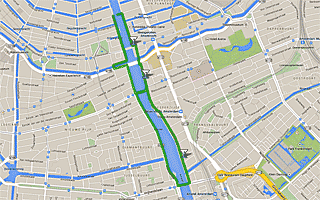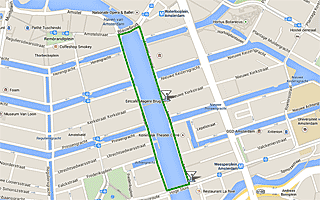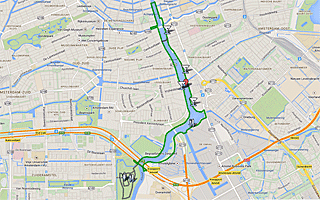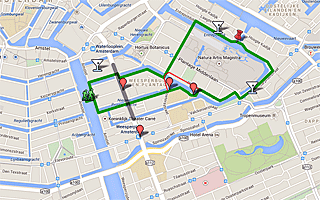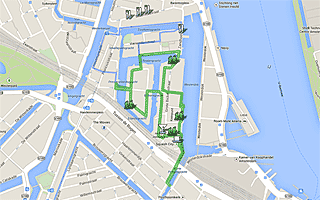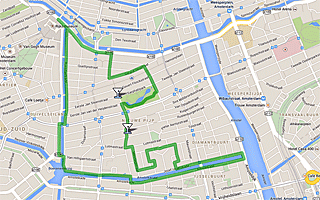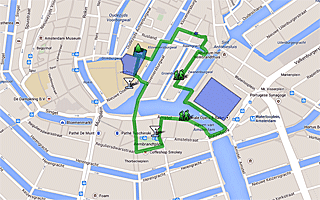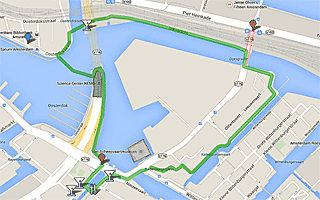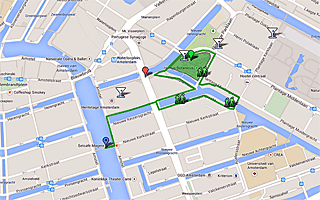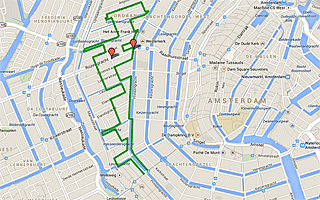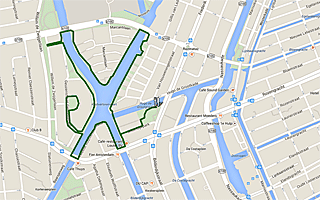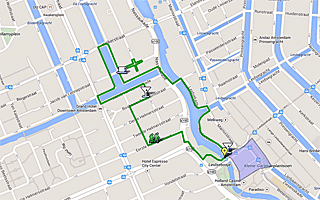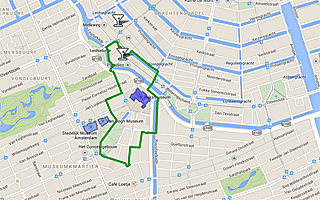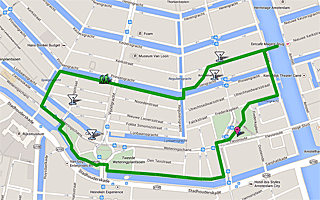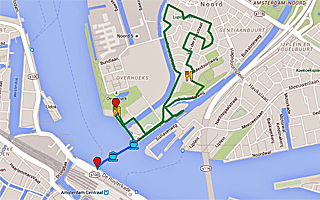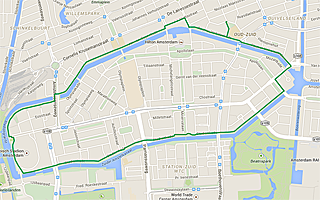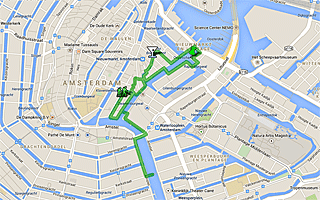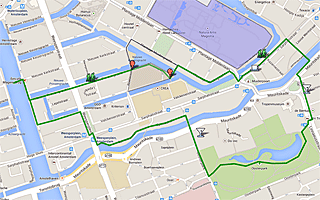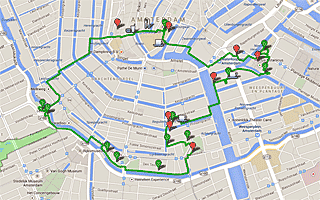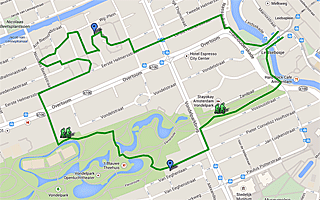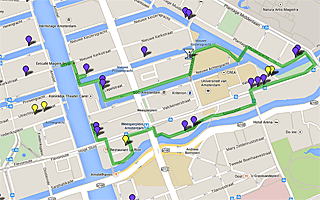Summer in the city
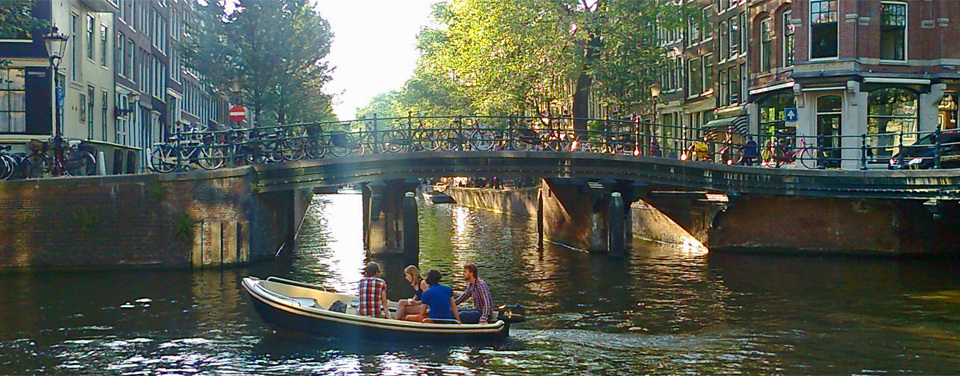
The sense of summer in Amsterdam
As cities go, Amsterdam is a very nice ‘summer city’. With so much water, so many trees, and places to conk out, under a tree, (or under a table at a pavement café if you overdo it). All of this sooths the sizzlingness of a hot summer day in the city. So you may not suffer at all, you might revel in it.
Summer walks in Amsterdam
Some of the walks that we select here are particularly nice in summer being either short and sweet (for balmy summer evenings) or longish, getting you away from the crowds to places where you'll have more leafy space. Especially for warm days, we have a few airy walks in places where you're fairly sure to find a nice spot beside the water, that kind of thing! So when the heat is on, take your book, camera (and some refreshments?) and follow one of these leafy trails. This applies to young and old alike.
-
Amstel River along the Weesperzijde Walk
The Amstel River is as much the essence of Amsterdam as the canals are, and no self-respecting tourist can return home without having had a stroll along the banks of the Amstel. This is a longer walk of 3 miles (5 km or so) but you can cut it a lot shorter by traversing one of the bridges, at Ceintuurbaan for instance.
However, if you do go the long haul, and walk as far as the Berlagebrug (bridge), you will not regret it. It takes you southwards, along the Amstel River, right on the riverside. On your way back, seeing the central city in the distance, you will get some idea of how Amsterdam appeared from afar in bygone days.
-
Amstel River and Reguliersgracht Walk
Lots to see on this short, round-trip walk, which is stunning on a beautiful morning or evening. During the day it is lovely too but it is more noisy and busy and this spoils its surprising city centre serenity. You can start on the Skinny Bridge (Magere Brug) and then follow the Amstel in a southerly direction. After that, the walk takes you through the Frederiksplein and Falckstraat, both of which are green oases.
This walk is very short and central yet gets you away from ‘the madding crowd’. It is easy to do in the evening and because you'll encounter umpteen bridges with their lovely lights, it's great after dark too.
-
Amstel River Short Walk
A lovely riverside walk in the heart of the city. Despite the short distance, it includes the essence of the city: canals, Theatre Carré, the Hermitage Museum, the upmarket Amstel Hotel, the Skinny Bridge (Magere Brug), the Stopera, and you'll cross the Prinsengracht, Keizersgracht and Herengracht on your way and may glimpse the towers of the Rijksmuseum. It's only about a mile so should take no more than 30 minutes, however, being such a picturesque walk, you may be tempted to dawdle and gaze at the nice vistas.
-
Amstel River Walk
Heading south along the Amstel River has a special feel to it. You leave the city behind and even though you look back at familiar landmarks, the widening river beckons.
At 10 km (6.3 miles), this is a satisfying walk and takes you outside the built-up urban area; it's fantastic to be able to escape the city so easily, just on foot. It's suitable for all seasons too, each season having its distinct appeal.
-
Artis Area and Entrepotdok Walk
A wonderful walk, it's not long, only a few miles / kilometres. The many weeping willows along the water are lovely in early spring. You can do this walk morning, noon or afternoon / evening, as long as it's still good and bright. There are some mighty poplars too along the way, two separate stands. The cherry trees are really pretty in early spring of course.
-
Bickerseiland, Prinseneiland, and Realeneiland Walk
Called the ‘Western Islands’ district, this area is made up of three islands of land joined by little bridges. Some parts are very quaint, whereas other stretches face dramatic vistas of modern dockland development, mostly business and residential. All in all, this area is pleasantly secluded, being a kind of cul-de-sac, and on a nice warm day you'll feel the benefit of being surrounded by water.
-
Brouwersgracht, Langestraat, and Herenmarkt Walk
When I think of autumn I see the Brouwersgracht. There's no objective reason for this but this walk does give autumn the pedestal it deserves. It's being able to hug the canal for such lovely long stretches and the cosy feel of the little streets that intersect with the canals. It's lovely on a golden September day but equally enjoyable on a sodden and blustery October evening.
-
Cherry Blossom Quayside Walk
This walk needs a sunny day, fantastic if there's cherry blossom but lovely in late spring or summer too but there must be sun. The views of the Rijksmuseum from the Hobbemakade are stunning and there are wonderful willows and poplars along the way as well as lots of other trees. It's a spacious and relaxed route, there are plenty of benches along the way so you could sit down for a read or a picnic.
-
City Hall, Stopera, Zuiderkerk, and University area Walk
Right in Amsterdam's city centre, this short walk of less than 1.5 miles will amaze you by its tranquillity. Although you're just a stone's throw from ‘the action’ you'll feel as if you're in a little village at times. Vary the route according to your mood and energy.
-
Docklands Dijksgracht Walk
Part of Amsterdam's beauty is that it's not all manicured and perfect. This walk is a great example of Amsterdam Raw – its ‘unclipped edges’. Peaceful and lush green for the most part, yet in the centre. You'll pass the Maritime Museum, ramble through dockland residential areas finding yourself in leafy bliss on waterside footpaths. The railway is ahead of you in the distance.
-
Hortus Botanicus (Botanic Garden) and surrounding area
This area is called the Plantage which translated means plantation, so I don't need to elaborate on the leafiness. But I will ha ha! Was there ever a small city district so beautifully planted with trees of such considerable age, variety, shade and texture! You'll find plane, lime, beech, elm, cypress, willow, poplar, birch, to mention but a few. Tree experts should love this area because there are lots of rare and mature specimens.
-
IJ Harbour and around via Oranjesluizen (locks)
Not for the faint-hearted! This 15 km (10 mile) tramp will take you to remote places where you need both a good map and a reasonable sense of direction. Although the length of the walk is not hugely strenuous, this route is remarkably rural and remote for a city walk. You'd be well advised to have some emergency nutrition with you, and water if it's a warm day. There is quite a stretch where you won't meet either a shop nor a café.
-
Jordaan South Walk
With street names like Roses Street (Rozenstraat), Eglantine Street (Egelantierstraat), Flower Canal (Bloemgracht), it should be no surprise that this area is blooming. The Jordaan is an area of little canals and streets, little bridges, little houses; everything here has big ‘cute’ appeal. In the morning or evening, it has a restful atmosphere, especially during the weekend.
-
Kostverlorenvaart Walk
This curiously shaped route (see map) represents a lovely walk beside water and trees in the west of Amsterdam. It's almost totally on a traffic-free footpath which gives it its special appeal and you should find it an utterly relaxing experience. You can start somewhere central in the city and walk to the Bilderdijkpark or you can take a tram. This route is only about 10 - 15 minutes on foot from the Jordaan, so it's quite near.
-
Leidse Loop
The bustling Leidseplein can be a pleasant oasis on a nice spring morning. This ‘Leidse Loop’ walk is a mixture of leafy canals and semi-pedestrian streets full of art for the interested passer-by. There's lots to see and enjoy on this walk that loops the Leidseplein.
-
Leidsekade to Da Costakade and back Walk
Take the Leidsekade (quayside) just around the corner from the hubbub of the Leidseplein, start by the American Hotel. Wander along the Leidse, van Lennep, and Da Costa quaysides; nose around in cute residential areas. You're never more than about 15 mins from the Leidseplein and yet you'll feel pleasantly ‘away from it all’. Although not called canals, these quayside ‘kade’ walks are every bit as nice, just not quite so old as the 400-year old canal ring.
-
Maritime Museum and Oosterkerk Walk
Lovely, leafy, waterside walk when you feel like something completely different. Despite being the old shipyard area and housing for the shipyard workers, this area is mainly recent residential architecture. Most of the old buildings were knocked down to make way for modern housing but it still feels authentic and it has been nicely planted with trees of all sorts.
-
Museum Route
A good route because you get to see a lot of the museums in a panorama and from a distance. The Rijksmuseum is wonderful but from Museumplein you can also see the Concertgebouw, the Stedelijk Museum and the van Gogh Museum. Nice too in winter because this walk is nice and spacious and so you get great vistas. Only about 1.5 miles so a doddle really.
Luckily the ‘Rijks’ is open again after a 10-year renovation, and I sincerely hope that all the building pre-fabs and other eyesores around the site will disappear soon. -
Nicolaas Witsenkade to Rijksmuseum Walk
Another lovely spring walk especially if the plane trees have come into leaf. The first part mainly plane trees but after that, from the Wetering Circuit onwards, you get a lovely sweep of weeping willow weeping away into the water. This part has a great backdrop with the Rijksmuseum behind, magnifique.
-
North - van der Pek district Walk
Wandering around the van der Pek district, you’ll see the attractive and sturdy architecture, small-scale planning, village atmosphere, and leafy green areas that distinguish this type of town-planning.
The walk includes a short trip on the ferry – from Central Station to the Buiksloterweg on the northern shore of the harbour. The ferry is free of charge because Amsterdam North is a part of the city; ferries depart very frequently and the time of the next ferry is clearly shown.
-
Olympic Stadium Loop Walk
Lengthy and peaceful waterside walk past a great variety of architecture.
During this walk you’ll explore a less-known area just at the edge of the centre where it’s quiet and spacious – wonderful on warm weekends when the city pavements can be thronged with (other) tourists. On this waterside loop you can walk at leisure, find a bench to sit, read, or dream, while enjoying lovely trees, pavement gardens, and interesting architecture along the way. This route goes around the Olympic Stadium, and the round-trip continues beside the water on the way back towards the city centre. You’ll be beside water most of the time and it’s relatively traffic-free and blissfully so in places.
-
Oosterpark, Eastern Islands, and the Kadijken Walk
Roam along leafy waterfronts, take your time in the beautiful Oosterpark, and admire the majestic Tropeninstituut (Institute & Museum of the Tropics) which you'll spot from a distance and can gaze at from many angles. Further along, the old eastern-island harbour area has a mix of wonderful old warehouse buildings and modern constructions, not all to ones taste, but interesting nonetheless. It's a great walking-area with few cars, some nice green areas and water, water, everywhere.
-
Oudeschans and Kromboomsloot area
Nice about this walk is that you can shorten it or just go with the flow and complete the few miles/kilometres. The route takes you along the Amstel, past the Opera City Hall and then down to the oldest area of the city. You'll see lovely old towers, the modern Nemo Science Museum (built like a ship) in the harbour and lots of typical Amsterdam facades and lovely canals along the way.
-
Oudeschans and Nieuwmarkt area walk
This walk and neighbourhood is a breath of tranquility sandwiched as it is between the hectic Nieuwmarkt square and the Waterlooplein Fleamarket. You'll be surprised and relieved to discover the peace and quiet immediately on leaving the busy streets.
-
Plantage and Hortus Botanic Gardens Walk
Gorgeous green walk which you can start on the Amstel in the centre. Includes two small parks with great trees and the pavement gardens in this area are hard to beat.
-
Plantage, south of the Zoo, and Oosterpark Loop
This is a fairly satisfying walk which will take you out of the inner city, starting at the Amstel River by the Skinny Bridge. Going east, you will head towards the zoo beside canals and other waterways. Then you will go south and west taking you back through the Oosterpark (Eastern Park) which makes for a nice leafy loop, fantastic in autumn. The walk is 2-3 miles but there's lots to see both natural and cultural.
-
Trees of Amsterdam walk
Here's quite a leafy walk to acquaint you with some Amsterdam trees. There are too many interesting trees to include in one walk, but this will be a good intro. It's a substantial distance (4.6 miles/7.5 km) but you can cut it shorter if you've had enough.
-
Vondelpark and WG-terrein Walk
An uplifting spring walk if ever there was. Lots of welcome spring charm, daffodils, and cherry blossom. Am beginning to sound like Dana now but this walk really is wonderful on a sunny day. From the Leidseplein, you'll roam through the Helmer district and back via the Vondelpark. It's a walk of discovery leading you along interesting residential streets and through the ‘WG terrein’ which was once the site, both grounds and buildings, of the ‘Wilhemina Gasthuis’ (Hospital).
-
Wisteria East Short Walk
Walk less than 2 miles and see some wonderful wisterias along the way. Amsterdam is of course full of wisteria and laburnum so this is just one of the routes but ends with one fantastic wisteria that'll make you whistle WOW!
Best in early to mid-May, towards end of May they are beginning to fade.
What you can see in summer in Amsterdam
Pavement Gardens in summer
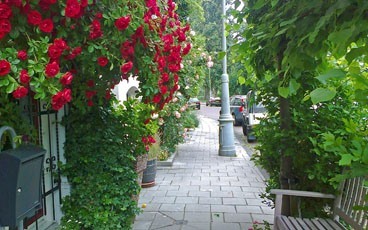 The pavement gardens come in to their own in the summer, from May or June onwards you could say. For the very reason that they are so small, they look best when they are in full bloom. The luxuriance belies the amount of ground available.
Although there's great variety in summer, the roses and hollyhocks are exceptional.
The pavement gardens come in to their own in the summer, from May or June onwards you could say. For the very reason that they are so small, they look best when they are in full bloom. The luxuriance belies the amount of ground available.
Although there's great variety in summer, the roses and hollyhocks are exceptional.
Everything in the pavement garden is Rosy!
Roses are red… and yellow… and white… and pink… and peachy. Roses love Amsterdam, the pavement gardens are festooned in them now, climbing and cascading over doors, windows, balconies. You could take photos every five steps and here are some pavement roses to whet your appetite.
The colours are vibrant so even it it's not sunny, they shine. You can walk and walk and you'll just be oohing and ahing all the way.
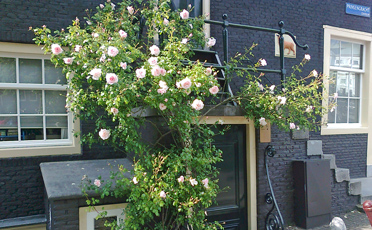
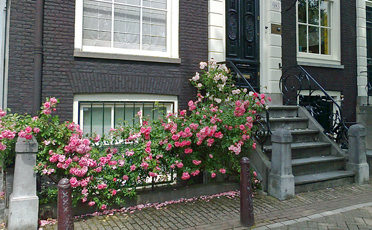
Lavender Lanes
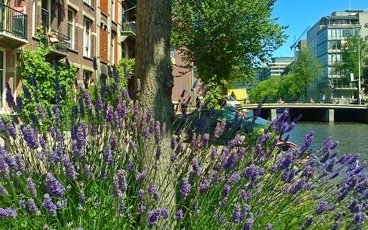 Lavender is about to bloom or blooming already and lavender has established itself as a perfect candidate for the pavement garden. Big cushions of it sit at the foot of the buildings adding to the scents of summer.
Lavender is about to bloom or blooming already and lavender has established itself as a perfect candidate for the pavement garden. Big cushions of it sit at the foot of the buildings adding to the scents of summer.
HHH: Hollyhocks, hydrangea and honeysuckle
Honeysuckle is flourishing by now as well and although some of you may consider it a nuisance, it does look and smell wonderful beside red roses. Hydrangeas are becoming widespread and look great, often brightening up dark corners.
Depending on the weather, the hollyhocks should be marching in all their glory from June onwards. They are superb, every colour imaginable, and they grow out of coin-sized nooks and crannies. The ‘guerilla gardeners’ of Amsterdam (myself included) have had a loose hand in deploying these happy flowers. We collect the seeds end of season, and scatter them wherever they're needed to brighten up dull and dingy corners. Their charm is in their chaotic colours and random dispersion, forestalling any pretty pretty choc-box effect.
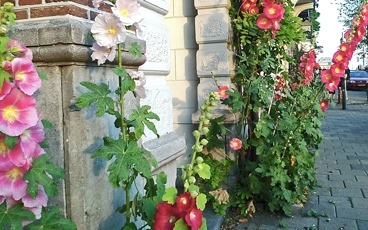
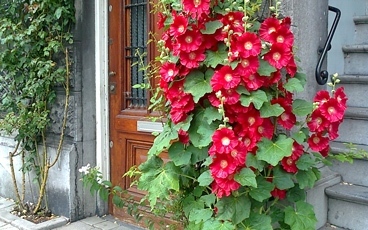
Gardens and inhabitants
The pavement gardens may have their inhabitants enjoying a coffee in the morning, or lunch, or a book, or a glass of wine, the newspaper, or dinner. Weather is usually better now and people have time off. I haven't included photos of the inhabitants because that's really infringing on their leafy privacy but they're usually chuffed if they happen to see you admiring their work.
That said, July & August are the months when there's a mass-exodus of Amsterdammers heading off on holiday. The city becomes much quieter, less need to sprint for the last table at the café, restaurant or pub. Parks, squares and streets outside the tourist-areas become nostalgically tranquil. You'll notice much less traffic, borne out by the abundance of free parking spaces. Even car-owners opt to walk or cycle when the weather is sunny and hot.
Of course nothing beats a secluded private garden, but for us passing by, there is something open and generous about these pavement gardens; it's as if they imbue everyone with a sense of well-being, and that's the intention too.
Trees in summer
If the trees in spring delight us with their pale-green hue, in summer they are a beautiful relief as well, giving shade and coolness in many a hot moment. There's nothing as nice as the shade of an airy, leafy tree when things get hot. No sun umbrella can compare and in Amsterdam there's no scarcity of leafy shade.
The trees all look magnificent of course, and the plane trees, of which there are many, look their best now. Plane trees can look a bit scruffy in their spring leaves, but in the full summer, they are glorious. Caucasian wingnut are widespread in Amsterdam and enhance many a summer park or square. Honey locust, swamp cypress, weeping willow, catalpa, birch, lime you'll encounter them all thriving near to the wonderful elm.
Summer nights
Warm summer nights: sitting outside at a café pub by the water around midnight. Just the sound of soft voices from other tables and the slosh of water when a boat chugs by, a refreshing glass of whatever - you'll feel at peace with the world.
Amsterdam Open Garden Days
Amsterdam Open Garden Days 2016 (June 17, 18, and 19, 2016)
A great opportunity to ramble around some select city gardens. The Open Garden Days is a recurring event every June.
